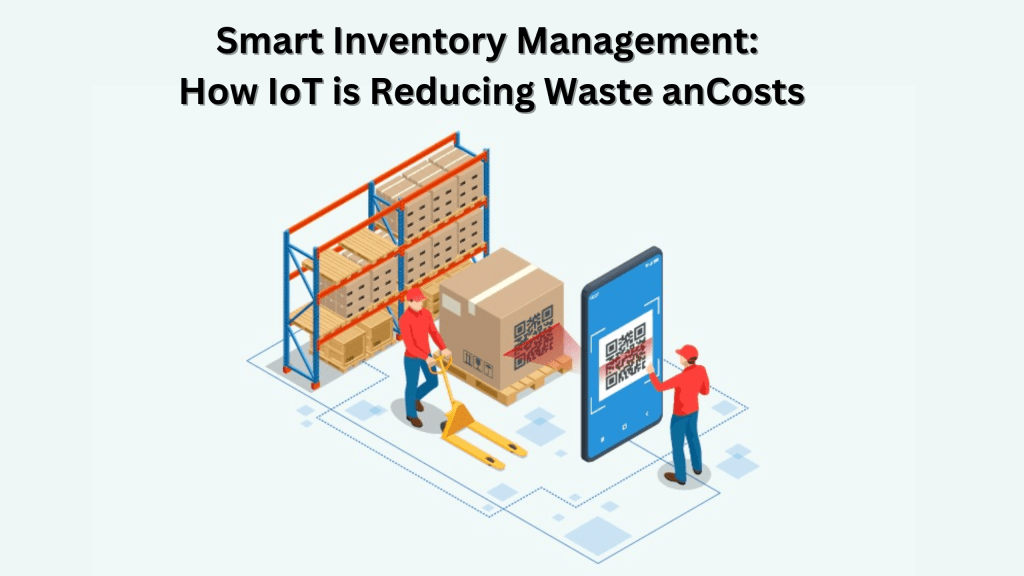Managing inventory efficiently is a critical challenge for industries, especially in sectors like manufacturing, retail, logistics, and healthcare. Poor inventory control can lead to overstocking, stockouts, increased waste, and financial losses. However, with the rise of Internet of Things (IoT), businesses are now leveraging smart inventory management solutions to track, monitor, and optimize stock levels in real-time.
IoT-powered inventory management uses RFID tags, smart sensors, AI-driven analytics, and cloud-based platforms to provide real-time visibility into inventory movement, ensuring businesses maintain the right stock levels while minimizing waste and reducing operational costs.
In this blog, we explore how IoT is transforming inventory management, its key benefits, and how businesses can integrate these smart solutions for greater efficiency.
1. How IoT Works in Inventory Management
Traditional inventory management relies on manual tracking, spreadsheets, and periodic stock audits, which often lead to errors and inefficiencies. IoT eliminates these challenges by using:
- RFID (Radio Frequency Identification) and Barcode Scanners: Track inventory in real-time and automate stock updates.
- Smart Sensors and IoT Tags: Monitor stock levels, expiration dates, and storage conditions.
- Cloud-Based Inventory Platforms: Provide remote access and automated inventory tracking.
- AI-Powered Analytics: Predict demand, optimize restocking, and prevent overstocking.
With these technologies, businesses can improve efficiency, accuracy, and responsiveness in inventory management.
2. Real-Time Inventory Tracking and Automation
IoT enables real-time tracking of raw materials, finished products, and warehouse stock, allowing businesses to:
- Monitor stock movement across different locations.
- Automate restocking alerts when inventory reaches a critical level.
- Prevent product loss due to theft, misplacement, or spoilage.
For example, in retail, IoT-powered RFID tags help track product movement from the warehouse to store shelves, ensuring retailers always have the right products in stock. In manufacturing, IoT sensors keep track of raw material availability, preventing production delays.
3. Reducing Waste with Smart Inventory Solutions
One of the biggest benefits of IoT in inventory management is reducing waste, particularly in industries dealing with perishable goods and time-sensitive products.
- Food & Beverage Industry: Smart sensors monitor temperature and humidity to prevent spoilage.
- Pharmaceutical Industry: IoT ensures medicines are stored at the correct temperature, reducing product wastage.
- Manufacturing Sector: IoT tracks material usage, ensuring excess raw materials are not wasted.
By optimizing stock levels and monitoring storage conditions, businesses can minimize waste, reduce costs, and increase sustainability.
4. Cost Savings Through Predictive Analytics
IoT-powered predictive analytics help businesses forecast demand more accurately, avoiding unnecessary stockpiling or shortages.
- AI-driven insights analyze sales trends and customer demand patterns.
- Automated stock replenishment ensures optimal inventory levels.
- Reduced operational costs by eliminating manual inventory audits.
For example, e-commerce businesses use IoT analytics to adjust stock levels based on real-time consumer behavior, reducing excess inventory while meeting demand efficiently.
5. Enhancing Supply Chain Efficiency
IoT integrates inventory management with supply chain logistics, allowing businesses to:
- Track shipments in real-time and estimate delivery times.
- Optimize warehouse storage with automated stock placement.
- Reduce transportation costs by improving route planning.
This level of visibility ensures that products move efficiently across the supply chain, reducing delays and enhancing customer satisfaction.
6. Improving Accuracy and Reducing Human Errors
Manual inventory tracking is prone to human errors, leading to miscalculations, misplaced stock, and costly mistakes. IoT eliminates these issues by:
- Automating inventory counts with RFID and barcode scanning.
- Detecting misplaced stock using IoT sensors.
- Sending automated alerts to reorder stock at the right time.
By reducing human intervention, businesses can increase accuracy and streamline inventory control.
7. The Future of IoT in Inventory Management
With advancements in AI, blockchain, and 5G connectivity, IoT-powered inventory management will become more intelligent, secure, and efficient. Future trends include:
- Autonomous Warehouses: AI-powered robots managing stock automatically.
- Blockchain for Inventory Transparency: Secure and tamper-proof tracking of goods.
- 5G for Faster Data Transmission: Real-time inventory updates with zero delays.
As businesses adopt these innovations, they will achieve higher productivity, lower costs, and a more sustainable inventory system.
Final Thoughts
Smart inventory management powered by IoT is revolutionizing industries by reducing waste, minimizing costs, and improving supply chain efficiency. Businesses that adopt IoT solutions can gain real-time visibility, predictive analytics, and automated inventory tracking, leading to better decision-making and higher profitability.
At Aknitech Automation, we specialize in IoT-driven inventory management solutions tailored for various industries. Whether you’re in retail, manufacturing, logistics, or healthcare, we can help you optimize your inventory processes with cutting-edge IoT technology.
Looking to upgrade your inventory management system? Contact us today and explore our IoT solutions.







